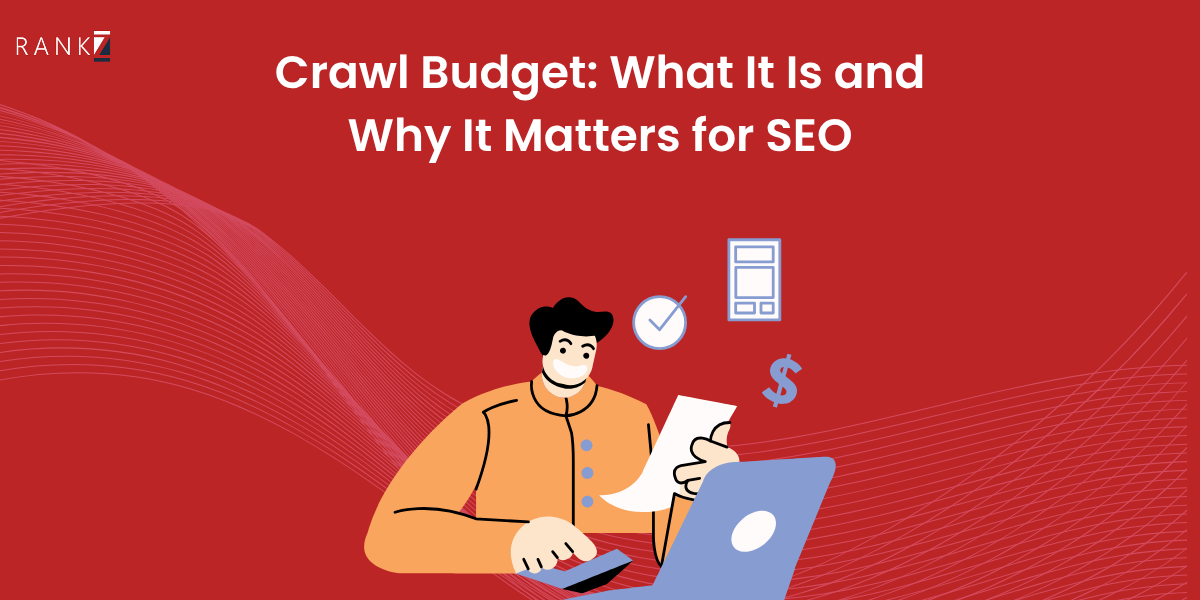Ever wondered why some of your web pages never make it to Google’s index, despite being live, crawlable, and even linked internally? The answer often lies in something that many website owners and even some SEOs overlook: crawl budget.
The crawl budget controls how frequently and how deeply search engine bots like Googlebot crawl your site. If you’re running a small blog, you might never hit its limits. But if you’re managing an e-commerce store with thousands of pages, the crawl budget can make or break your visibility on search engines.
In this guide, we’ll break down exactly what crawl budget is, why it matters, how search engines calculate it, and—most importantly—what you can do to optimize your crawl budget for better indexing and rankings.
What Is Crawl Budget?
Crawl budget is the number of pages a search engine web crawler, like Googlebot, is willing to crawl on your site within a given timeframe.
It’s not a single metric but a result of two key components:
1. Crawl Rate Limit
This is the maximum number of simultaneous connections Googlebot will use to crawl your site, and the time it will wait between requests. If your server is fast and stable, Google may increase this rate. If it’s slow or times out often, Googlebot backs off.
2. Crawl Demand
Crawl demand is determined by how important and popular your pages are. Pages that get more external links or are frequently updated tend to be crawled more often. Google doesn’t want to waste resources crawling unimportant or low-performing pages.
Together, these two factors shape your effective crawl budget.
Why Crawl Budget Matters for SEO
Your site’s crawl budget directly influences how much of your content gets discovered, crawled, and indexed by search engines. If important pages aren’t getting crawled, they won’t appear in search results.
Here’s how crawl budget impacts your SEO:
- Indexation Issues: If Googlebot doesn’t crawl a page, it won’t index it. That means no visibility in search, no traffic, no conversions.
- Wasted Resources: If crawl budget is being spent on duplicate pages, session-parameter URLs, or thin content, your important pages might get left behind.
- Delayed Updates: Even if a page is already indexed, if it isn’t crawled again after changes, outdated information may still show in search results.
- SEO Efficiency: Sites with optimized crawl budgets perform better in large-scale SEO, especially for enterprise or e-commerce websites.
Whether you run a blog, a SaaS platform, or a product-heavy e-commerce store, your crawl budget affects how efficiently search engines interact with your website.
How Google Determines Crawl Budget
Google has stated that crawl budget is mostly a concern for sites with over 1,000 URLs or dynamically generated pages. That said, it’s useful for anyone doing technical SEO to understand how it’s calculated.
Here are the factors that influence crawl budget:
1. Site Popularity: Pages that get more backlinks or traffic tend to be crawled more frequently. Google prioritizes URLs that are considered valuable.
2. Content Freshness: If your content is updated regularly, Googlebot will return more often. Stale pages with no updates for years tend to get ignored.
3. Crawl Health: This includes how fast your server responds, how many errors it returns (404s, 500s), and whether the site crashes or slows down during crawling. A healthy server encourages higher crawl limits.
4. Internal Linking: Well-structured internal links help distribute crawl budget across your site. Orphaned pages (those with no internal links pointing to them) are less likely to be discovered.
5. Robots.txt and Meta Tags: If you accidentally block useful pages or fail to disallow duplicate ones, your crawl budget gets misallocated.
6. Sitemaps: Submitting a sitemap doesn’t increase your crawl budget, but it helps Google find and prioritize key URLs faster.
Common Crawl Budget Issues
Even sites with decent authority and backlinks suffer from crawl budget waste. Here are the usual suspects:
1. Duplicate Content: This includes URL parameters, session IDs, printer-friendly pages, and near-identical product descriptions. Google may crawl all versions unnecessarily.
2. Orphan Pages: These are pages that exist on your site but aren’t linked from anywhere else. Without links, they’re hard for bots to discover.
3. Broken Links and Redirect Chains: Broken links waste crawl attempts. Redirect chains (e.g., A → B → C → D) slow crawling and reduce efficiency.
4. Thin Content Pages: Pages with little to no unique content offer minimal value to search engines. They get crawled less and may be skipped entirely.
5. Poorly Configured Robots.txt: Blocking entire directories or dynamic URLs without knowing what’s in them can cause you to waste crawl resources, or worse, block important content.
6. Excessive Faceted Navigation: In e-commerce, filter and sort options often generate tons of URLs with slight variations. Without proper parameter handling, this can cripple crawl efficiency.
Tools to Monitor and Analyze Crawl Budget
You can’t manage what you can’t measure. Here are some key tools to help track your crawl activity and identify crawl budget issues:
1. Google Search Console
- Check the Crawl Stats Report under Settings.
- It shows average daily crawl requests, response times, and total crawled kilobytes.
2. Screaming Frog SEO Spider
- Visualize crawl paths.
- Spot redirect chains, duplicate pages, and crawl depth issues.
3. Log File Analyzer
- Analyze your raw server logs to see which URLs Googlebot visits.
- Helps identify where crawl budget is being wasted.
4. JetOctopus / Sitebulb / DeepCrawl
- Offer visual dashboards.
- Help segment crawl data by page type, status code, or crawl frequency.
How to Optimize Crawl Budget
Once you’ve identified crawl budget issues, it’s time to fix them. Optimization is all about ensuring Googlebot spends its time on pages that matter.
Here’s a breakdown of proven strategies:
1. Improve Site Speed and Server Performance
Googlebot adjusts its crawl rate based on your server’s ability to handle requests. If your site speed is slow or it returns frequent 5xx errors, your crawl budget will drop.
How to fix it:
- Use a CDN to serve static content faster.
- Enable browser caching and compression.
- Audit TTFB (Time to First Byte) and reduce server load.
- Choose a reliable hosting provider with scalable infrastructure.
2. Block Unnecessary URLs with Robots.txt
Your crawl budget shouldn’t be wasted on low-value pages like admin panels, filters, or internal search results.
Examples of what to block:
Disallow: /search/
Disallow: /cart/
Disallow: /*?sort=
Be careful, though—blocking a page in robots.txt also means it won’t be crawled and therefore can’t be indexed (unless indexed through other means). Use this wisely.
3. Use Canonical Tags to Consolidate Duplicates
If you have the same product or blog post accessible through multiple URLs, add a canonical tag to signal the preferred version.
<link rel=”canonical” href=”https://example.com/product/shoes123″>
This helps focus crawl efforts on a single, authoritative version of each page.
4. Clean Up Thin and Low-Value Pages
Google has limited patience for weak pages. Pages with under 100 words of text, duplicate content, or empty templates waste crawl resources.
Solutions:
- Add useful content where appropriate.
- Merge thin pages into comprehensive guides.
- Use noindex for pages you want to keep but don’t want indexed.
5. Submit a Clean and Prioritized XML Sitemap
Google uses your sitemap to understand the structure and priority of your content.
Best practices:
- Include only index-worthy URLs.
- Update the sitemap when new content is added.
- Use lastmod tags to show recent changes.
6. Handle URL Parameters Smartly
URLs like /product?id=123 and /product?id=123&utm=fb may lead to duplicate crawling. Google can interpret them as separate pages.
Fixes:
- Use Google Search Console’s URL Parameter Tool to inform how Google handles parameters.
- Add canonical tags.
- Keep URLs clean using server-side rewrites or static slugs.
7. Strengthen Internal Linking
Crawl budget is often wasted on poorly linked pages. Make sure every important page is reachable within 3 clicks from the homepage.
Tips:
- Use breadcrumb navigation.
- Link related content with clear anchor text.
- Audit for orphan pages and link to them.
8. Use Pagination and Faceted Navigation Carefully
E-commerce sites often struggle with crawl traps. Avoid auto-generating thousands of pages through filter/sort options.
Tips:
- Use rel=”next” and rel=”prev” for paginated content.
- Canonicalize faceted pages to the main category URL.
- Block filtered URLs using robots.txt or noindex.
Crawl Budget for Large vs. Small Websites
The impact of crawl budget varies significantly depending on your site size.
Large Sites (10,000+ URLs)
Common in:
- News sites
- E-commerce stores
- SaaS apps with dynamic content
Challenges:
- Crawl traps from filters and session IDs
- Multiple language versions
- Frequent content updates
Priorities:
- Use log file analysis to monitor crawl behavior
- Segment your site into crawl-efficient sections
- Noindex or block junk URLs at scale
Small Sites (Under 1,000 URLs)
Most blogs and local business websites don’t hit crawl budget limits.
Still important to:
- Fix broken links
- Avoid duplicate content
- Submit XML sitemaps
- Ensure crawlable navigation
Even if your site is small, preparing for scale ensures you don’t run into problems later.
Conclusion
Understanding and optimizing your website’s crawl budget is essential for maximizing your visibility in search engine results. While crawl budget may not be a critical concern for small sites with fewer than a few thousand pages, it becomes increasingly important for large, complex websites with dynamic content, faceted navigation, or inefficient internal linking.
By addressing common issues such as duplicate content, poor site architecture, and unnecessary crawlable URLs, webmasters can ensure that search engine bots spend their limited crawl resources on the most valuable pages. Tools like Google Search Console, server logs, and site audits can help identify crawl inefficiencies and opportunities for improvement.
Ultimately, a well-optimized crawl budget helps search engines index your site more effectively, improving your chances of ranking well and reaching your target audience. Crawl budget may not be the most glamorous SEO topic, but for many websites, it’s a hidden lever that can make a measurable difference.
FAQ’s About Crawl Budget
1. What’s the difference between crawl rate and crawl budget?
- Crawl rate is how fast Googlebot makes requests.
- Crawl budget is how many pages it will crawl in a given session.
Rate is about speed; budget is about volume.
2. Can I increase my crawl budget?
You can’t request more crawl budget directly, but you can influence it by:
- Improving server performance
- Getting more backlinks
- Publishing high-quality, frequently updated content
3. Should I worry about crawl budget if I have a small site?
Generally, no. But it’s still a good practice to:
- Avoid thin and duplicate content
- Use proper internal linking
- Monitor Google Search Console for crawl anomalies
4. Does crawl budget affect ranking?
Not directly. But if your content isn’t crawled, it can’t be indexed. If it’s not indexed, it can’t rank.
Crawl budget impacts discoverability, which is a prerequisite for ranking.


